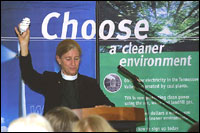Sister Evelyn Mattern had two goals in mind as she stood vigil recently with a Protestant colleague in a gas mask, singing, “This Air is My Air!” at the North Carolina statehouse.
Her short-term aim was to lend support to stricter regulations for the state’s coal-fired power plants. Yet she also had a loftier, long-range objective, one increasingly shared by a wide array of activists: to transform the way Americans think about energy in time to stave off global warming.
“I don’t think we’re going to have a mass movement anytime soon, but I don’t think it takes that many people to make a difference,” says the nun, who, at 61, recalls the prominent role played by faith groups during the civil rights struggles.
It might not be a mass movement quite yet, but what the emerging grassroots effort to combat climate change lacks in numbers and unity, it’s making up for in diversity, and, increasingly, respectability. Religious organizations form one part of that effort, and scores of municipal governments and college campuses have also taken up the mantle of climate activism. The net effect has been to make climate change — once seen as the controversial purview of tree-huggers and policy wonks — an increasingly Main Street concern.
“The growth of this movement has been very, very rapid, and absolutely fascinating to watch,” says Michael Northrop, a program officer for the Rockefeller Brothers Fund, which has provided financial backing for some of the initiatives.

Getting Real
Spurring the movement on is a sea change in American opinion, brought about by a scientific consensus that has all but ended the previously fierce debate over whether the climate crisis is overblown. In a milestone report last year, the U.S. National Academy of Sciences declared that global warming was a real and worsening problem. That announcement followed a series of increasingly conclusive reports from the United Nations-sponsored Intergovernmental Panel on Climate Change. Recently, even the ever-intransigent Bush administration acknowledged that global warming was real, most likely fueled by human activities, and certain to have a dramatic impact on the American environment (although President Bush later distanced himself from the report).
As scientists have spoken with more certainty — and as people have personally witnessed strange weather patterns, most recently the East Coast’s extended drought — climate change has become more newsworthy. Reporters have aggressively pursued controversies such as Bush’s decision last year to withdraw from the Kyoto Protocol, the international agreement to confront global warming, and his subsequent release of a strikingly laid-back climate plan focused on reducing “greenhouse gas intensity” (the volume of emissions divided by economic output) rather than emissions per se.

Rev. Sally Bingham sees the lightbulb.
Photo: The Regeneration Project.
“Americans have accepted that global warming is real and that we’re contributing to it,” says the Rev. Sally Bingham, a climate activist based in San Francisco, Calif. “Whereas just three years ago, we always used to get questions about whether climate change was a natural phenomenon, no one asks that anymore.”
Religious activism on climate issues has become increasingly common; in just the past two years, a vigorous interfaith organization has sprung up, with chapters in 21 states supporting education, political action, and nitty-gritty greenhouse gas reductions at members’ congregations. In June 2001, America’s Roman Catholic bishops unanimously backed a statement calling for immediate action to mitigate the effects of global warming. Last February, more than 1,200 religious leaders of different denominations signed a letter to U.S. senators calling for specific measures to curb climate change, such as increasing vehicle fuel efficiency and regulating carbon dioxide emissions from power plants.
“In this case, the religious community has been led by science,” says Paul Gorman, who runs the New York-based National Religious Partnership for the Environment. “And this is very noteworthy, considering that these two communities have been so deeply at odds in the past.”
Out Kyoto-ing Kyoto
Noteworthy progress has also been made in the secular realm. Over the past 12 months, the list of U.S. municipalities belonging to the Climate Protection Campaign, run by the Toronto-based International Council for Local Environmental Initiatives, has grown to 129 — double last year’s number. Cities signing on must commit to reduce their greenhouse gas emissions; some, including Seattle and Salt Lake City, have set targets well beyond the terms of the Kyoto Protocol. That protocol, which was endorsed by President Clinton but subsequently abandoned by Bush, would have required the U.S. to cut greenhouse gas emissions by 7 percent below 1990 levels by 2012.

Get on the bus, Gus: an alternative-fuel
airport shuttle in Boston.
Photo: Clean Airport Partnership, Inc.
Several of these local governments have already made progress toward their goals, investing in energy conservation, public transportation, and alternative fuels. In San Francisco last November, voters overwhelmingly approved a $100 million bond measure promoting solar and wind power. Boston, meanwhile, plans to convert its bus fleet to hybrid vehicles and eventually to fuel-cell power.
A powerful incentive for copycats is the money these cities say they’ve saved by improving energy efficiency. In a preliminary estimate in the year 2000, some 60 participants calculated they’d cut energy costs by a net $94 million, according to ICLEI’s researchers.
Scores of college campuses are following the same course, completing greenhouse gas inventories and starting to cut fossil-fuel consumption, in large part by upgrading their heating, lighting, and air-conditioning systems. The campus movement began in earnest in 1999, when Tufts University’s then-President John DiBiaggio pledged that his campus would start working immediately to meet the Kyoto target. Others soon followed — with some school administrations taking the lead, and the rest pushed along by determined student protests.
Only Connect
Lacking overall direction by professional environmentalists, the climate change movement has been led from the ground up, by a strikingly diverse set of people — from 20-year-old Julian Dautremont-Smith, a long-haired Lewis & Clark College student who lobbied the school for greenhouse reductions, to the city councils of such Main Street locales as Toledo, Ohio, and Decatur, Ga.
Some of these grassroots activists are motivated by empathy for the world’s poor, who are likely to feel the first and worst impacts of meteorological turmoil. Others are driven by the desire to stem the species extinctions hastened by a warming Earth. Still others worry about their own children’s futures.
Secular and religious activists alike say the relatively recent involvement of faith-based groups has given the movement a powerful boost — “a moral voice and sign of long-term commitment,” in Gorman’s words. Indeed, not since the anti-Apartheid movement have so many priests and rabbis so concertedly urged their congregants to take political action, and nothing else demonstrates so clearly that global warming has become a mainstream concern.
But while Gorman insists the faith groups are “quite pointedly independent of environmental organizations,” others involved in the movement are rooting for more collaboration.

Sister Evelyn Mattern:
doin’ it for herself.
“We’ll work with anyone involved in our issues,” says Mattern, the North Carolina nun. As an example, her local group, known as Climate Connection, joined the local Canary Coalition and the national American Lung Association to fight for clean smokestacks, because upgrading the state’s power plants would help reduce both smog and greenhouse gases.
In recent months, a handful of philanthropic foundation officials have been meeting to try to find ways to encourage such partnerships among the movement’s scattered forces. “There are lots of things the average Joe wants to support,” says Reid Detchon, a coordinator at the U.N. Foundation. Detchon is working with funders to develop a new project — the Energy Future Coalition — to bring together business, labor, and nonprofits to address alternative solutions to energy problems and to bolster campaigns such as San Francisco’s recent vote to fund solar power.
Stateside
Although there’s no evidence that climate activists are swaying Bush’s stance on the Kyoto Protocol, it’s likely that they’ve been a factor in energizing several state legislatures on climate issues.
Five years ago, Oregon established the first meaningful U.S. state measure to control emissions of carbon dioxide, the leading greenhouse gas, by requiring new energy facilities to avoid, sequester, or offset a portion of their emissions.
New Jersey recently pledged to reduce its greenhouse gas emissions by 3.5 percent below 1990 levels by 2005. And last August, the governors of six New England states and premiers of seven Eastern Canadian provinces took a particularly dramatic stand, agreeing to roll back emissions by at least 10 percent below 1990 levels by 2020.
California topped them all earlier this month, however, by passing a pioneering law that requires automakers to reduce their vehicles’ carbon dioxide emissions by 2009. If it survives legal challenges from the automotive industry, the law could go a long way toward limiting greenhouse gas emissions by changing how passenger vehicles are manufactured in the U.S.
Voters’ anxiety about climate change has also helped support what are now scores of related bills on Capitol Hill. More than 70 proposals are pending on such issues as fuel efficiency, power plant emissions, and a national strategy to stabilize atmospheric concentrations of greenhouse gas emissions.
The majority of these proposals reflect a much more acute concern than does Bush’s climate change action plan. But then so, it seems, do an increasing number of mainstream American institutions.
Whether the progress so far is enough to have an impact on the climate is another question entirely. Scientists agree that simply to stabilize the greenhouse gases already in the atmosphere and halt the warming trend, we would have to reduce our emissions by at least 70 percent. So far, none of the grassroots developments, including the predominantly voluntary city and state measures, has promised to deliver that kind of cut.
But climate activists keep the faith.
Mattern, the North Carolina nun, says the movement still lacks the size to change history, but adds, “It’s our job to build it.”
